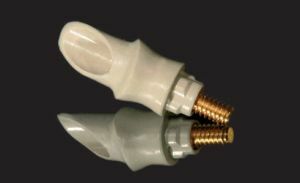 The abutment is a high-strength joint element that integrates individual components of the prosthetic structure.
The abutment is a high-strength joint element that integrates individual components of the prosthetic structure.
The lower part of the abutment is attached to the implant, and the artificial tooth surface( crown) is fixed on the upper abutment. It can be installed both after full implant engraftment, and immediately after the end of surgery.
Contents
- Current classification
- modern methods
- fixation methods Materials used in the
- manufacturing What the
- market offers
- Functional value and installation steps
- care rules Possible complications
Modern classification of
First of all, the adapters are divided into two types: standard and individual. Standard elements have certain parameters that are unchanged in their serial production.
The individual abutment is distinguished by a high cost and an ideal fit to the gum. Such products are made from casts removed from the patient's jaw, and significantly reduce the risk of inflammation during implantation.
Both standard and individual abutments for implants are divided into several subgroups:
- The gum contour formers are cylindrical in shape and differ in diameter, size and shape.
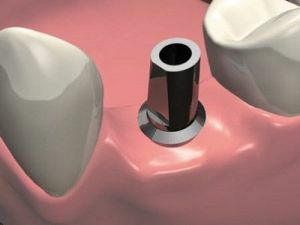 The gum former refers to temporary elements and performs( in contrast to the abutment) a slightly different function. Its task is to prevent microbes from penetrating into soft tissues and to allow the gums to find the right contour. Despite the fact that this element is installed for a short enough period of time( up to two weeks), it is made of high-strength metal - titanium.
The gum former refers to temporary elements and performs( in contrast to the abutment) a slightly different function. Its task is to prevent microbes from penetrating into soft tissues and to allow the gums to find the right contour. Despite the fact that this element is installed for a short enough period of time( up to two weeks), it is made of high-strength metal - titanium. - Standard .Their assortment is presented in six different variations along the length and in two in the height of the upper corner.
- Direct .They are among the most common and often used in dental implantology.
- Corner .They are easy to use, because they allow you to connect the elements of the structure, located in different angular planes.
- Ball type .They are used in conditionally removable prosthetics.
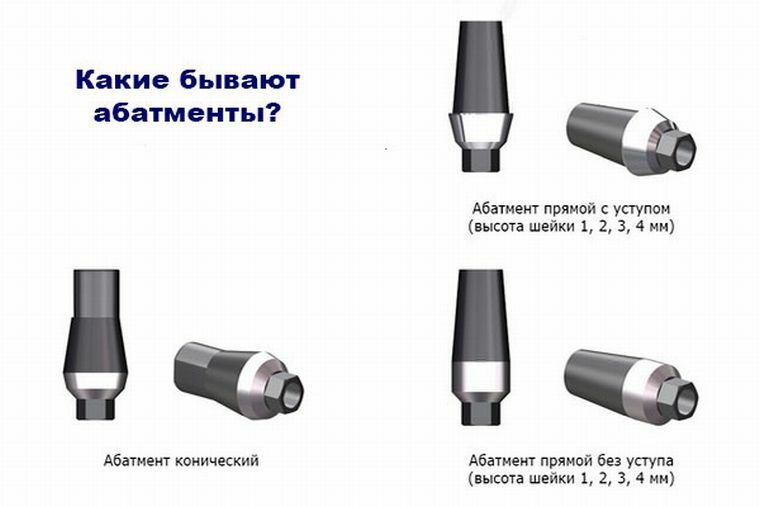
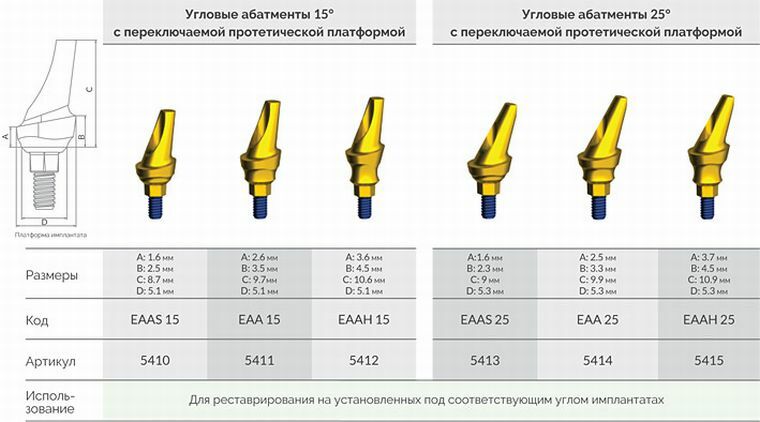
Abutments manufactured by Alfa Bio
Fixation methods
Coupling attachments are attached to the prosthesis in two ways: with a screw or special cement. Screw fixing allows you to fix the dental crown on the adapter in such a way that, if necessary, it can be unscrewed and unobstructed to make a replacement of the structure.
In order to avoid overloading and failure of all elements of the future implant, the nozzle is fixed in the zone of least stress.
During cement fixing, the individual parts of the prosthesis are treated with a special compound, which, when hardened, will reliably hold the structure in place.
Materials used in the manufacture of
Several basic materials are used for the manufacture of abutments:
- Plastic adapters are the most affordable option for those who do not have the opportunity to take advantage of higher quality elements.
- Ceramic products in most cases do not cause the patient any allergic reactions and allow to choose the
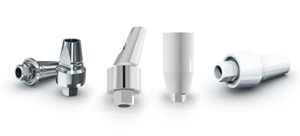 the optimal shade for a more aesthetic appearance.
the optimal shade for a more aesthetic appearance. - The zirconia abutment allows maximum engraftment with implantation, as it perfectly contacts live tissue.
- Titanium elements are ideal for the restoration of chewing teeth. This strong and reliable mechanism is in an affordable price range, but it is not recommended for implantation of the frontal group of teeth due to the fact that it will be too noticeable under the prosthesis.
- Also often used in the manufacture of titanium and zirconium compounds .Such products are manufactured exclusively on individual orders, and combine strength and a beautiful outer shell.
What the market
offers Since abutments are part of prosthetic structures, many foreign and domestic teams are working on their creation and development, among which several quite popular brands:
- Nobel .A world-famous manufacturer of implants guarantees the quality and durability of its products. Presenting to the attention of dental clinics an extensive assortment of connecting elements made of titanium, zirconium dioxide and gold alloys, the company Nobel gives the consumer the opportunity to choose available in quality and cost design.
- Alpha Bio .This Israeli company produces fairly inexpensive products with excellent biocompatibility. Different types of abutments allow for maximum fit to the gum tissue.
- Xive .The German company, which uses pure titanium for the production of its products, simply can not deal with the production of poor-quality products. Thanks to the latest developments, the Xive joints are securely attached to the prosthesis and allow the implants to quickly take root in the bone tissue.
- Locator .These adapters can be used for partial or full prosthetics on implants. Double fixing gives confidence that the design will be securely fixed in the oral cavity.
- MIS .Due to the fact that the connecting products of this manufacturer are multicomponent, they are used in removable and conditionally removable prosthetics for fast and durable fixation of structures.

Functional Value and Installation Steps
 At its core, the abutment helps to connect the implant, installed in the jawbone, to the crown part of the artificial tooth.
At its core, the abutment helps to connect the implant, installed in the jawbone, to the crown part of the artificial tooth.
Without this element, the implantation process can not be completed successfully. In non-removable prosthetics, the abutment serves as a support for the crowns and bridges.
The abutment is installed in several stages:
- Setting of the gingiva driver .This contributes to the rapid recovery of tissues and prevents the entry of microbes into the wound.
- Scheduled inspection .After the implant, securely fixed in the root canals of the tooth, fully acclimatized, the doctor carefully examines the area of osseointegration and removes special stubs, thus preparing a place for a permanent abutment.
- Anesthesia of the site , at which all necessary manipulations will be carried out.
- Install and fasten the binder element .
Despite the strength, the connecting element is quite capable of breaking under the influence of strong pressure, and disrupt the osseointegration of the implant.
In addition to rejection, this development can lead to disturbances in the restoration of bone tissue and significant damage to it.
For this reason, it is very important to choose the correct site for screwing in the adapter and carefully monitor that it has a minimum share of voltage.
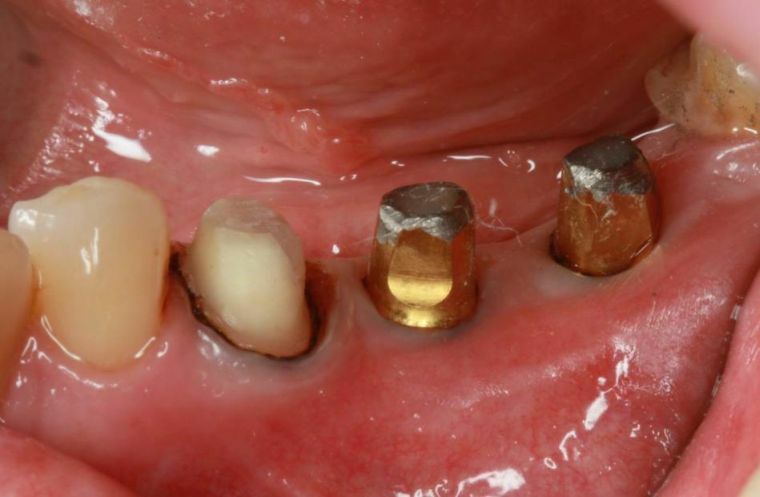
Care instructions
In the first few days after installation, there may be some soreness, so using a toothbrush for oral hygiene is strictly not recommended. In this period, it is desirable to do rinsing.
Once the swelling of the tissues is reduced, you can carry out a more thorough cleaning of the inflamed area. For such hygienic procedures it is desirable to use a brush with a soft bristle.
After the discomfort completely disappears, the doctor will allow for more thorough hygiene.
Possible complications of
In some cases, just before the abutment is installed, the implant can be twisted from the root canal. This is due to a change in the structure of the bone tissue, it becomes more loose and stops holding the implant. For her 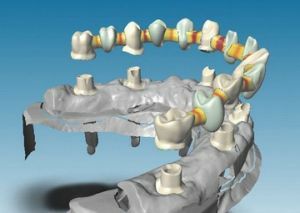 recovery and strengthening, the doctor will prescribe drugs that include calcium.
recovery and strengthening, the doctor will prescribe drugs that include calcium.
When the gums develop on the implant, the excess tissue is carefully removed by the doctor. Then the gingiva former is installed.
Postoperative complications include: swelling, bleeding, seam divisions, bleeding gums and increased pain.
In addition, the adapter can loosen, fall out and even break. In such situations, the patient should contact his doctor for help as soon as possible.
The price of a standard titanium abutment is approximately 3500-4000 rubles. The implementation of an individual order will cost the client of the dental clinic about 5000 rubles. Adapter of zirconium is much more expensive - 16-17 thousand rubles.
